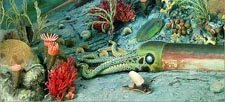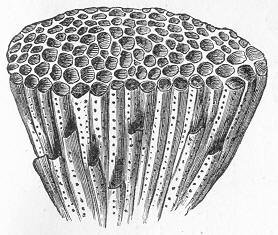 |
 |
 |
 |
 |
Produced
by the Population Genetics and Evolution class, Furman University |
||||
 |
 |
 |
 |
 |
Produced
by the Population Genetics and Evolution class, Furman University |
||||
 |
The
Ordovician: Corals |
 |
||
| Although a few
coral-like species existed during the Cambrian period, corals did not
play a very significant role in the marine ecosystem until their numbers
increased during the Ordovician period (Fossil Museum 2008). There were
three major types of corals during the Ordovician period: the Tabulata,
the Rugosa, and the Heliolitida (Waggoner et al. 1994). Tabulata were
colonial and formed structures out of hexagonal cells that resembled honeycombs.
They were named after horizontal internal partitions, called tabulae,
which developed within each cell (Fossil Museum 2008). On the other hand,
the best known Rugosa corals were the horn corals, solitary polyps that
formed a conical or horn-like 'shell' that could be nearly a meter long
(Waggoner et al. 1994). There is evidence that they formed symbiotic relationships
with worms that inadvertently entered their basal openings (Elias 1986).
Heliolitida was the smallest out of the three, but all three formed massive
reefs. However, despite the increase in abundance of corals during the
Ordovician period, the reef ecosystem continued to be dominated by algae,
sponges, and in some cases by bryozoans (Fossil Museum 2008). During the
mass extinction event during the late Devonian period, Heliolitida went
extinct. Although Rugosa and Tabulata corals were both hit hard, they
were able to recover and flourish until the end of the Permian period.
They went extinct during the Permo-Triassic mass extinction about 245
million years ago (Waggoner et al. 1994). Page by Laura Snyder |
 |
| Photo Credit: The Virtual Fossil Museum | |
| Elias RJ. 1986. Symbotic relationships between worms and solitary rugose corals in the late Ordovician. Paleobiology 12:32-45. Waggoner BM, Collins A, Smith D. 2006. Anthozoa Fossil Record. University of California Museum of Paleontology. Accessed Feb. 8, 2010. Virtual Fossil Museum. 2008. Class Anthozoa. www.fossilmuseum.net. Accessed Feb 8, 2010. |